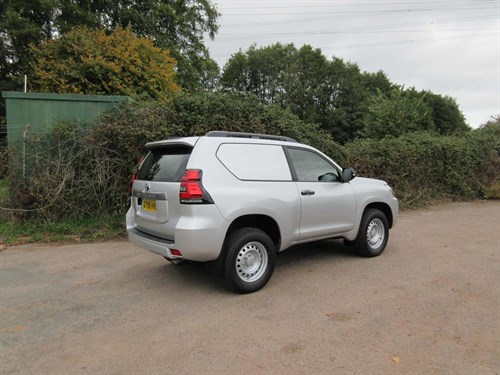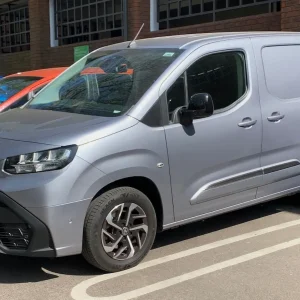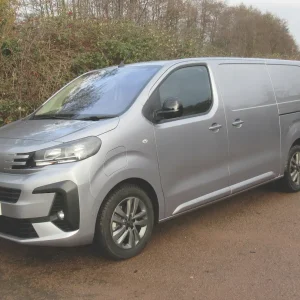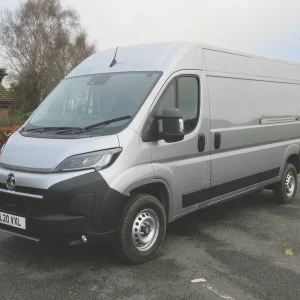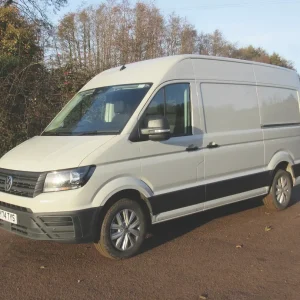The default choice for many businesses that need to venture off-road from time to time is a 4×4 double-cab pick-up – but it is not the only option.
A small number of four-wheel drive vans of varying capacities and capabilities are also available and – depending on the model you select – may feel rather more like a car to drive than most pick-ups do.
Toyota has decided to venture into what is admittedly a niche sector of the light commercial vehicle market with a van version of the 4×4 Land Cruiser.
Produced in both short- and long-wheelbase guise, with three and five doors respectively, the Land Cruiser Utility Commercial was launched at last April’s Commercial Vehicle Show. It is a potential alternative to the legendary Hilux depending on the nature of the work you are on.
It is a van with few direct rivals and they seem to be getting fewer by the day. Mitsubishi’s classic Shogun Commercial is departing and – at the budget end of the market – Dacia’s Duster Commercial has gone, which is a great shame.
Returning to the Utility Commercial, it comes with one engine choice – a 2.8-litre pumping out 175hp – and one level of specification. We took to the chilly rural highways of Herefordshire and Gloucestershire in the short-wheelbase variant.
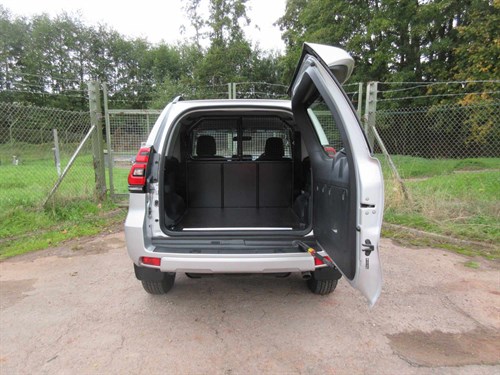
Load bay
Access to the load box is by means of a single rear door hinged to the right and assisted by a gas-filled strut. The door is glazed and the window has a heater, but there is no wash/wipe system, which is a disadvantage if you end up splashing about in a lot of sloppy mud.
The door opens to reveal a 1.57m3 load area with sides that are well-protected against minor scratches and scrapes by a variety of plastic mouldings. A timber floor is fitted, and while cargo tie-down points appear to be in short supply – we could only see two and would like a few more – a sturdy-looking steel half-height bulkhead topped off by a full-height mesh grille should hopefully protect whoever is in the cab from any unsecured items that come flying forwards.
Roof rails are fitted to create a bit more carrying space. If your are fitting a roof rack, however, then bear in mind that this light commercial’s fuel consumption will be affected – and don’t put too much weight on it.
No spare wheel is provided, alas. You have to rely on a tyre inflator positioned in a compartment just inside the rear door instead. We would rather see a proper spare wheel.
Head across rough terrain and there is always the risk that a tyre will end up with a severe gash in its sidewall – too big a gash for an inflation system to deal with.
A 12V power point sits just inside the door too (you can’t have too many power sockets).
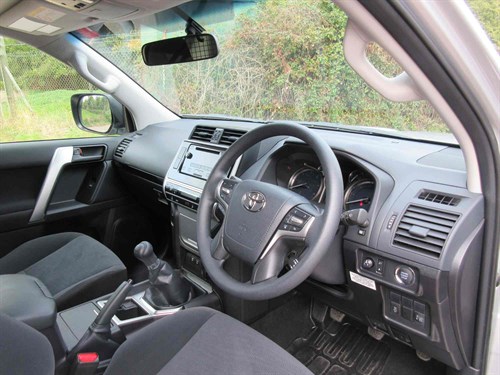
Interior and equipment
It just goes to show how far light commercial vehicle design has come in recent years when you are disappointed because a dashboard does not come with a full-colour touchscreen.
The Utility Commercial is touchscreen-free, instead featuring a black, slab-like display that controls the radio/CD player. A USB port forms part of a rather basic Bluetooth-enabled package that includes an aux-in socket.
But we shouldn’t moan too much. That’s because the Utility Commercial boasts air-conditioning after all, plus LED front fog lights, cruise control, electric windows and electrically-adjustable and heated exterior mirrors that can be flipped inwards at the touch of a button.
Nor is there any shortage of storage space inside. For your hard-earned money you acquire a lidded and lockable glovebox, a lidded shelf in the middle of the dashboard, bins in each of the doors with mouldings to hold soft drink cans, and two cup-holders, plus a tray between the seats. The cupholders can be covered with a lid – to keep your espresso warm, perhaps?
Also between the seats along with a 12V power point is a deep, lidded bin with a tray just under the lid. There is plenty of room behind the seats for dirty boots, anoraks and other accoutrements. Both the driver’s seat and the steering wheel are height-adjustable.
The design of the interior also enables you to see clearly ahead and to either side.
Driver, driver’s knee, passenger and side curtain airbags are fitted but the onboard electronic safety systems installed should hopefully help ensure they are not required. They include ABS, vehicle stability control, electronic brakeforce distribution, brake assist, and active traction control along with tyre pressure warning system. Ventilated disc brakes are installed all round.
Turning to the suspension on the vehicle, a double-wishbone arrangement helps support the front while a four-link lateral rod set-up assists in underpinning the rear. Our Utility Commercial sat on 17-inch steel wheels that were shod with Bridgestone Dueller H/T 245/70 R17 tyres and graced with silver-coloured caps.
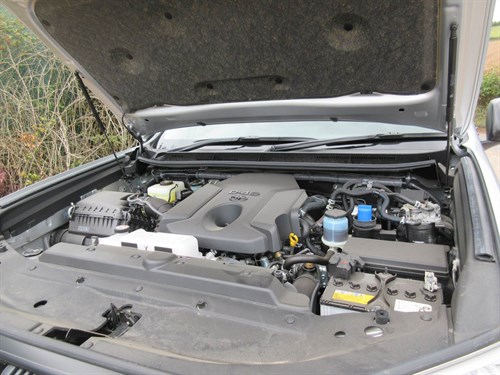
Engine and gearbox
You push a button to fire up the four-cylinder in-line 16-valve 2,755cc turbodiesel engine, assuming you have the key fob present (it’s not an arrangement the writer is especially keen on). It’s a big engine for the size of vehicle.
Maximum power kicks in at 3,400rpm while top torque of 420Nm makes its presence felt across a 1,400-2,600rpm plateau.
The AdBlue top-up point is under the bonnet, which is supported by a pair of gas-filled struts.
The engine is married to a six-speed manual gearbox. Four-wheel drive is permanently engaged and you twist a knob to switch to a low-ratio set of gears if required. A Torsen limited-slip diff is fitted as well.
Driving
Strong acceleration and sharper handling than you might expect from a 4×4 with a comparatively high centre of gravity are among the Utility Commercial’s plus points. It feels solidly planted on the highway, which gives the driver confidence. It rides acceptably too, coping with everything from country lanes to pot-holed A- and B-roads without complaint.
Slightly tighter rack-and-pinion steering would be appreciated though, as would a crisper gear change, and while it would be wrong to describe the cab interior as noisy, a bit more sound-deadening would be welcome.
Turning through a farm gate and beginning to squelch across a field before tackling a steep, slippery embankment, we quickly discovered that the Utility Commercial was more than capable of coping with muddy and uneven terrain. Before we ascended the embankment we engaged the lower ratio gears, but it probably wasn’t necessary – the Toyota would doubtless have lumbered up the slope in high ratio. After that we crossed an even soggier field before trundling down a deeply-potholed farm track – all conditions that the off-roading load-lugger might encounter during the course of a busy working day.
We’re happy to report that it coped with the lot without breathing hard. Ground clearance is 205mm with a wading depth of 700mm.
During our off-road pottering we encountered the odd boulder or two. As we slithered over them we recalled that the Land Cruiser’s front and rear bumpers and its ladder-frame cross-member have been designed to slide across obstacles.
Some off-roaders have box-shaped cross-members that can get caught on obstructions, bringing the vehicle to a juddering and unwelcome halt, with damage potentially done. The Utility Commercial’s slanted cross member is shaped in such a way that it slips over such hazards.
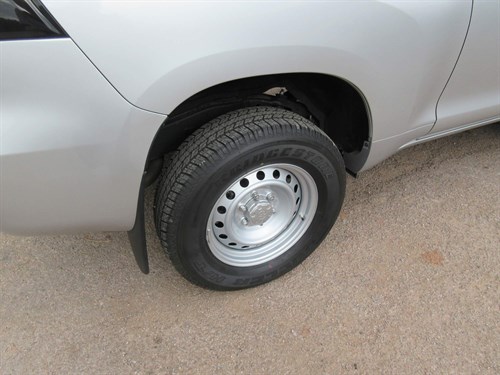
Operating
Fuel economy? We averaged around 33mpg compared with the official combined figure of 37.6mpg.
While not outstanding, it is a little better than we expected given that four-wheel drive is always engaged.
At 12 months/10,000 miles the service intervals are too short, and need to be extended.
They could be accompanied by interim safety inspections if the vehicle is used off-road extensively and might have suffered damage without the owner being aware of what has happened.
The short service interval contrasts with the long duration of the comprehensive warranty.
A five-year/100,000-mile package protects your acquisition and is accompanied by three-year paintwork and 12-year anti-corrosion perforation warranties.
One year’s AA roadside rescue and recovery is provided too that, like the service interval, could stand to be lengthened.
The Utility Commercial would benefit from external side rubbing strips to protect it from minor damage.
This was especially the case with our demonstrator because it was finished in optional silver metallic paint with colour-keyed bumpers.
An alarm is included in the deal with perimeter and interior protection.
It makes sense given that the driver may be carrying power tools and other equipment that need to be defended against thieves.
A steel cargo body certainly offers better protection against theft than an open pick-up bed.
In summary, the permanent 4×4 – plus a low-ratio set of gears, a limited slip diff and plenty of ground clearance – and the rugged construction makes one wonder whether some customers might see the Toyota Land Cruiser Utility Commercial as a potential replacement for their ageing Land Rover Defenders now they have gone out of production.
Toyota Land Cruiser Utility Commercial SWB
Price (ex VAT) £26,636
Price range (ex VAT) £26,636-£27,599
Gross payload 593kg
Load volume 1.57m3
Load length 1,170mm
Load width(min/max) 1,065/1,450mm
Load bay height 1,040mm
Loading height 838mm
Rear door aperture 1,016×1,162mm
Gross vehicle weight 2,600kg
Braked trailer towing weight 3,000kg
Residual value 44.3%
Cost per mile 47.9p
Engine size/power 2755cc, 175hp @ 3,400rpm
Torque 420Nm @ 1,400-2,600rpm
Gearbox 6-spd
Fuel economy 37.6mpg (combined)
Fuel tank 87 litres
CO2 197g/km
Warranty 5yrs/100,000mls
Service intervals 1yr/10,000mls
Insurance group 43E
Price as tested £27,219
Options fitted
Metallic paint £583
Rivals
Land Rover Discovery Commercial
Price (ex VAT) £40,975-£52,875
Load volume 1.9m3
Gross payload 721-883kg
Engines 240hp 2.0 diesel, 306hp 3.0 diesel
Verdict: Eye-wateringly pricey, this 4×4 is what you want if you’re eager to impress the neighbours, although customers might wonder how you can afford one. A hugely impressive piece of kit, but we question whether acquiring one solely as a working tool really makes sense.
Mitsubishi Shogun Sport Commercial
Price (ex VAT) £30,000 (est)
Load volume 1.5m3
Gross payload 600kg
Engines 181hp 2.4 diesel
Verdict: This Mitsubishi 4×4 uses the same ladder-frame chassis as the L200 pick-up, but gets a multi-link coil suspension system at the back rather than leaf springs. That’s good for on-the-road handling, and it’s competent enough off-road too. Standard eight-speed auto ’box is to be applauded.
Volkswagen Transporter 4Motion
Price (ex VAT) £27,285-£35,270
Load volume 5.8-9.3m3
Gross payload 987-1,126kg
Engines 150hp, 204hp 2.0 diesel
Verdict: Not a 4×4 van that’s designed for arduous off-road work, but one that should get up an icy country lane with an urgent delivery in mid-winter. Build quality is exemplary and there is far more space in the back than the Utility Commercial or Shogun SportCommercial can muster.
The Final Verdict
|
Design |
8/10 |
A chunky, purposeful off-roader. |
|
Cabin |
8/10 |
Comfortable enough with lots of storage. |
|
Ride |
8/10 |
Copes well with Britain’s rough and ready road surfaces. |
|
Refinement |
7/10 |
In-cab noise could be better quelled, but rock-solid build quality. |
|
Load area |
7/10 |
Easy to access and a beefy-looking bulkhead. |
|
Handling/performance |
8/10 |
Looks more than capable of coping with off-road assignments. |
|
Engine/transmission |
7/10 |
Former has bags of power, latter could offer a smoother change. |
|
Standard equipment |
7/10 |
Most of the features you need but no dashboard touchscreen. |
|
Operating costs |
7/10 |
Service intervals too short. Economy better than we thought. |
|
What Van? subjective rating |
7/10 |
Well put together. Could be a smart alternative to 4×4 pick-ups. |

